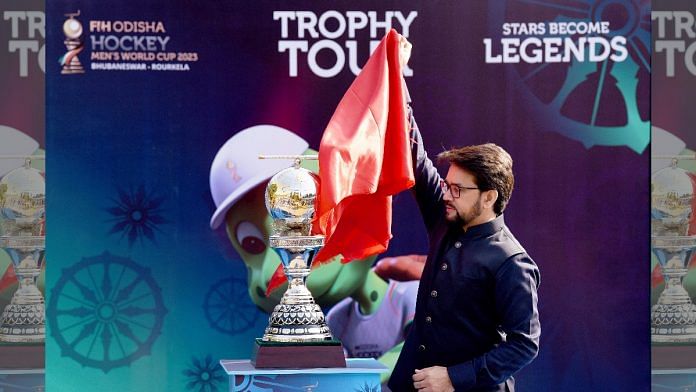New Delhi: In 2018, Belgium won their first hockey title — the FIH Men’s Hockey World Cup — against arch-rivals and three-time champions the Netherlands at Bhubaneshwar’s Kalinga Stadium. The tournament returns to Odisha Friday with capital city Bhubaneswar and planned city Rourkela splitting the hosting duties between them.
Held every four years, this year marks the fourth World Cup to take place after the implementation of new rules mandated by the Fédération Internationale de Hockey (FIH) in 2014. It is also the third tournament since then to take place in India.
The FIH rules of hockey are updated every two years following the Olympics or the World Cup. Prior to the 2014 World Cup at The Hague in the Netherlands, the federation announced a list of changes to be implemented later that year, arguably mirroring the impact made by the elimination of the offside rule in 1992 as well as the advent of AstroTurf pitches in the 1970s.
While these 20th-century changes are fairly well-documented, the reforms made since 2014 are perhaps less widely understood by fans across generations. ThePrint takes a look at some of these new gameplay rules.
Also Read: From Eden Gardens to Gol Maal — how Pelè made his way into India’s popular memory
70 minutes to 60, halves to quarters
On 20 March 2014, after successful trial runs conducted by the Euro Hockey League and the now-defunct Hockey India League, the FIH announced that from September of that year, all international matches would be divided into quarters totalling 60 minutes. The move meant that the 2014 edition of the Men’s World Cup would be the last of its kind to feature the traditional 70-minute match length divided into halves.
Additionally, the new rules also allotted a 40-second timeout when a penalty is awarded and when a goal is scored, to allow for “on-field celebration time”. This meant that field hockey would now follow the lead of far more popular sports including ice hockey, basketball, and American football.
“The new format will result in a higher intensity, faster paced and more exciting game of hockey. It will enable event organisers and broadcasters to develop more engaging fan experiences, both at the venue, on TV and online. With an increase in opportunity to review highlights, explain the game and add colour to the play, people from all over the world can have a better lens on the exciting sport of hockey,” the FIH media release stated at the time.
Two of the first global events to feature these new match structures were the 2016 Rio Olympics and the 2018 World Cup in Odisha, and the differences in outcomes were nuanced but noticeable, with teams and coaches forced to make tactical adjustments to their styles of play to maximise on the game-time available.
While the 2012 London Olympics and the 2014 World Cup at The Hague saw 4.87 and 4.26 goals scored on average per game respectively under the traditional structure, the 2016 Rio Olympics, the 2018 Odisha World Cup and the 2020 Tokyo Olympics witnessed 4.97, 4.36 and 5.50 goals per game respectively within the shorter match lengths.
Also Read: ‘Happy to tour… get chopped up,’ Iceland Cricket trolls Pakistan after England whitewash
Latest round of changes prioritises player safety
In the eight years since these significant rule reforms, the FIH has continued to make smaller but still essential amendments to its rulebook every few years. While the 2017 and 2019 updates offered deeper clarifications of existing rules and minor uniform regulations, the 2022 version mentioned two bigger changes to the rules of play that prioritised players’ safety.
The first concerns the wearing of protective equipment during and immediately after penalty corners. As part of the change, players belonging to the team defending their goal during the penalty corner can “continue to play the ball outside the (shooting) circle after an interception” as well as run with the ball after the corner. However, they must remove their protective equipment “at the first opportunity” within the 23-metre line beyond the shooting circle.
The second focusses on aerial balls. Since the older rules were vague on the permissible way for players to play and intercept aerial balls — creating greater risk of collisions and head injuries — the amended rules provide greater specifics.
“Players must not approach within 5 metres of an opponent receiving a falling raised ball until it has been received, controlled and is on the ground. The ball may be intercepted within 5 metres but outside of playing distance provided it is done safely. The initial receiver has a right to the ball. If it is not clear which player is the initial receiver, the player of the team which raised the ball must allow the opponent to receive it,” the rulebook now states on aerial balls.
Since the institution of these rules, India has played in three international tournaments, the 2022-23 FIH Men’s Pro League (which will continue into July this year), the 2022 Men’s Asia Cup and the 2022 Commonwealth Games.
While the top-level Men’s Pro League has seen 4.28 goals per game so far, the Asia Cup in Jakarta and the Commonwealth Games in Birmingham featured a whopping 6.25 and 6.96 goals per game respectively. However, this discrepancy was largely due to the involvement of lower-level national teams such as Scotland, Bangladesh, Indonesia, and Ghana competing with top sides like India, Australia, and England.
(Edited by Theres Sudeep)
Also Read: Morocco’s rise in Qatar is knocking at the doors of football history. This time for Africa



